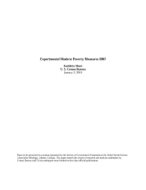
An official website of the United States government
Here’s how you know
Official websites use .gov
A .gov website belongs to an official government organization in the United States.
Secure .gov websites use HTTPS
A lock (
) or https:// means you’ve safely connected to the .gov website. Share sensitive information only on official, secure websites.
-
//
- Census.gov /
- Library /
- Census Working Papers /
- Experimental Modern Poverty Measures 2007
Experimental Modern Poverty Measures 2007
Experimental Modern Poverty Measures 2007
Abstract
This paper presents some new developments in the experimental poverty measure series prepared by the Census Bureau. The developments respond to drafted legislation aimed at improving the official poverty measure. The main areas addressed include the unit of analysis and imputations for necessary expenditures to be subtracted from income. The unit of analysis changes from the Census defined family to include cohabiting couples and young unrelated children previously excluded from the universe for the calculation of poverty statistics. Methods to impute medical out-of-pocket spending and spending for childcare, have been updated with more recent data than were previously used. Efforts are made to use a consistently defined threshold with the concept of the unit of analysis and the concept of out-of-pocket spending on basic goods. Thus, mortgage principal payments were included in the threshold. Responding to the proposed legislation, two thresholds are employed based on housing tenure and presence of mortgage or housing subsidy.
Estimates of poverty rates incorporating these changes are presented and compared to previously released poverty rates. In general, updated estimates of out-of-pocket spending are higher than earlier imputed values and poverty thresholds that included principal payments for mortgages were higher than previously employed thresholds. These developments result in higher poverty rates overall than those using older methods. Using thresholds based on housing status produced lower poverty rates for some groups, particularly the elderly.
Others in Series
Working Paper
Working Paper
Working Paper
Share
Related Information
WORKING PAPER
Supplemental Poverty Measure Working PapersSome content on this site is available in several different electronic formats. Some of the files may require a plug-in or additional software to view.
 Yes
Yes
 No
NoComments or suggestions?


Top

